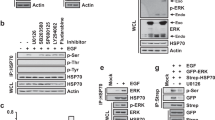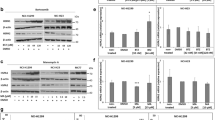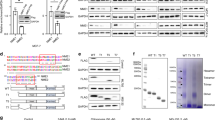Abstract
Earlier studies indicated that density-arrested cancer cells released an unidentified growth inhibitor whose secretion was prevented by overexpression of the lysosomal protease cathepsin D (cath D). In this study, this growth inhibitor was purified by affinity chromatography and identified as the heat shock cognate 70 protein (hsc70) based on its peptide microsequencing and specific antibody recognition. Among intracellular proteins, including other heat shock proteins, only constitutive hsc70 was secreted in response to the high-cell density. Moreover, hsc70 secretion from cancer cells was generated by serum deprivation, whereas its cellular concentration did not change. Prevention of Hsc70 secretion by cath D overexpression was associated with the formation of multilayer cell cultures, thus indicating a loss of contact inhibition. In addition, we showed that supplementing the culture medium with purified hsc70 inhibited cell proliferation in the nanomolar range. Conversely, removal of this extracellular hsc70 from the medium by either retention on ADP-agarose or competition at the Hsc70 binding site restored cell proliferation. Hsc70 appears active in human breast cancer cells and hypersecreted by direct cath D inhibition. These results suggest a new role of this secreted hsc70 chaperone in cell proliferation that might account for the higher tumor growth of cancer cells overexpressing cath D.
This is a preview of subscription content, access via your institution
Access options
Subscribe to this journal
Receive 50 print issues and online access
$259.00 per year
only $5.18 per issue
Buy this article
- Purchase on Springer Link
- Instant access to full article PDF
Prices may be subject to local taxes which are calculated during checkout






Similar content being viewed by others
References
Abercrombie M . (1979). Contact inhibition and malignancy. Nature 281: 259–262.
Abercrombie M, Heaysman JE . (1954). Observations on the social behaviour of cells in tissue culture. II. Monolayering of fibroblasts. Exp Cell Res 6: 293–306.
Agarraberes FA, Terlecky SR, Dice JF . (1997). An intralysosomal hsp70 is required for a selective pathway of lysosomal protein degradation. J Cell Biol 137: 825–834.
Anagnostopoulou A, Vultur A, Arulanandam R, Cao J, Turkson J, Jove R et al. (2006). Differential effects of Stat3 inhibition in sparse vs confluent normal and breast cancer cells. Cancer Lett 242: 120–132.
Baldwin ET, Bhat TN, Gulnik S, Hosur MV, Sowder II RC, Cachau RE et al. (1993). Crystal structures of native and inhibited forms of human cathepsin D: implications for lysosomal targeting and drug design. Proc Natl Acad Sci USA 90: 6796–6800.
Barreto A, Gonzalez JM, Kabingu E, Asea A . (2003). Stress-induced release of Hsc70 from human tumors. Cell Immunol 222: 97–104.
Beckmann RP, Mizzen LE, Welch WJ . (1990). Interaction of Hsp 70 with newly synthesized proteins: implications for protein folding and assembly. Science 248: 850–854.
Bossard N, Descotes F, Bremond AG, Bobin Y, De Saint Hilaire P, Golfier F et al. (2003). Keeping data continuous when analyzing the prognostic impact of a tumor marker: an example with cathepsin D in breast cancer. Breast Cancer Res Treat 82: 47–59.
Brighty DW, Jassal SR . (2001). The synthetic peptide P-197 inhibits human T-cell leukemia virus type 1 envelope-mediated syncytium formation by a mechanism that is independent of Hsc70. J Virol 75: 10472–10478.
Brocchieri L, Conway de Macario E, Macario AJ . (2008). hsp70 genes in the human genome: conservation and differentiation patterns predict a wide array of overlapping and specialized functions. BMC Evol Biol 8: 19.
Chen S, Brown IR . (2007). Translocation of constitutively expressed heat shock protein Hsc70 to synapse-enriched areas of the cerebral cortex after hyperthermic stress. J Neurosci Res 85: 402–409.
Chiang HL, Dice JF . (1988). Peptide sequences that target proteins for enhanced degradation during serum withdrawal. J Biol Chem 263: 6797–6805.
Chiang HL, Terlecky SR, Plant CP, Dice JF . (1989). A role for a 70-kilodalton heat shock protein in lysosomal degradation of intracellular proteins. Science 246: 382–385.
Ciocca DR, Calderwood SK . (2005). Heat shock proteins in cancer: diagnostic, prognostic, predictive, and treatment implications. Cell Stress Chaperones 10: 86–103.
Ciocca DR, Fuqua SA, Lock-Lim S, Toft DO, Welch WJ, McGuire WL . (1992). Response of human breast cancer cells to heat shock and chemotherapeutic drugs. Cancer Res 52: 3648–3654.
Ciocca DR, Rozados VR, Cuello Carrion FD, Gervasoni SI, Matar P, Scharovsky OG . (2003). Hsp25 and Hsp70 in rodent tumors treated with doxorubicin and lovastatin. Cell Stress Chaperones 8: 26–36.
Clayton A, Turkes A, Navabi H, Mason MD, Tabi Z . (2005). Induction of heat shock proteins in B-cell exosomes. J Cell Sci 118: 3631–3638.
Cohen LA, Tsuang J, Chan PC . (1974). Characteristics of rat normal mammary epithelial cells and dimetyhylbenzanthracene-induced mamary adenocarcinoma cells growth in monolayer culture. In Vitro 10: 51–62.
Dressel R, Grzeszik C, Kreiss M, Lindemann D, Herrmann T, Walter L et al. (2003). Differential effect of acute and permanent heat shock protein 70 overexpression in tumor cells on lysability by cytotoxic T lymphocytes. Cancer Res 63: 8212–8220.
Dworniczak B, Mirault ME . (1987). Structure and expression of a human gene coding for a 71 kd heat shock ‘cognate’ protein. Nucleic Acids Res 15: 5181–5197.
Eagle H, Levine EM . (1967). Growth regulatory effects of cellular interaction. Nature 213: 1102–1106.
Elledge RM, Clark GM, Fuqua SA, Yu YY, Allred DC . (1994). p53 protein accumulation detected by five different antibodies: relationship to prognosis and heat shock protein 70 in breast cancer. Cancer Res 54: 3752–3757.
Florin L, Becker KA, Sapp C, Lambert C, Sirma H, Müller M et al. (2004). J Virol 11: 5546–5553.
Fouchaq B, Benaroudj N, Ebel C, Ladjimi MM . (1999). Oligomerization of the 17-kDa peptide-binding domain of the molecular chaperone HSC70. Eur J Biochem 259: 379–384.
Garcia M, Derocq D, Pujol P, Rochefort H . (1990). Overexpression of transfected cathepsin D in transformed cells increases their malignant phenotype and metastatic potency. Oncogene 5: 1809–1814.
Garcia M, Platet N, Liaudet E, Laurent V, Derocq D, Brouillet JP et al. (1996). Biological and clinical significance of cathepsin D in breast cancer metastasis. Stem Cells 14: 642–650.
Geminard C, Nault F, Johnstone RM, Vidal M . (2001). Characteristics of the interaction between Hsc70 and the transferrin receptor in exosomes released during reticulocyte maturation. J Biol Chem 276: 9910–9916.
Glondu M, Liaudet-Coopman E, Derocq D, Platet N, Rochefort H, Garcia M . (2002). Down-regulation of cathepsin-D expression by antisense gene transfer inhibits tumor growth and experimental lung metastasis of human breast cancer cells. Oncogene 21: 5127–5134.
Goldfarb SB, Kashlan OB, Watkins JN, Suaud L, Yan W, Kleyman TR et al. (2006). Differential effects of Hsc70 and Hsp70 on the intracellular trafficking and functional expression of epithelial sodium channels. Proc Natl Acad Sci USA 103: 5817–5822.
Hightower LE, Guidon Jr PT . (1989). Selective release from cultured mammalian cells of heat-shock (stress) proteins that resemble glia-axon transfer proteins. J Cell Physiol 138: 257–266.
Kao RH, Francia G, Poulsom R, Hanby AM, Hart IR . (2003). Application of differential display, with in situ hybridization verification, to microscopic samples of breast cancer tissue. Int J Exp Pathol 84: 207–212.
Lazaris A, Chatzigianni EB, Panoussopoulos D, Tzimas GN, Davaris PS, Golematis B . (1997). Proliferating cell nuclear antigen and heat shock protein 70 immunolocalization in invasive ductal breast cancer not otherwise specified. Breast Cancer Res Treat 43: 43–51.
Liaudet E, Derocq D, Rochefort H, Garcia M . (1995). Transfected cathepsin D stimulates high density cancer cell growth by inactivating secreted growth inhibitors. Cell Growth Differ 6: 1045–1052.
Mambula SS, Calderwood SK . (2006). Heat shock protein 70 is secreted from tumor cells by a nonclassical pathway involving lysosomal endosomes. J Immunol 177: 7849–7857.
Mambula SS, Stevenson MA, Ogawa K, Calderwood SK . (2007). Mechanisms for Hsp70 secretion: crossing membranes without a leader. Methods 43: 168–175.
Marchesini N, Osta W, Bielawski J, Luberto C, Obeid LM, Hannun YA . (2004). Role for mammalian neutral sphingomyelinase 2 in confluence-induced growth arrest of MCF7 cells. J Biol Chem 279: 25101–25111.
Melendez K, Wallen ES, Edwards BS, Mobarak CD, Bear DG, Moseley PL . (2006). Heat shock protein 70 and glycoprotein 96 are differentially expressed on the surface of malignant and nonmalignant breast cells. Cell Stress Chaperones 11: 334–342.
Metcalf P, Fusek M . (1993). Two crystal structures for cathepsin D: the lysosomal targeting signal and active site. Embo J 12: 1293–1302.
Morimoto RI . (1998). Regulation of the heat shock transcriptional response: cross talk between a family of heat shock factors, molecular chaperones, and negative regulators. Genes Dev 12: 3788–3796.
Multhoff G, Botzler C, Wiesnet M, Muller E, Meier T, Wilmanns W et al. (1995). A stress-inducible 72-kDa heat-shock protein (HSP72) is expressed on the surface of human tumor cells, but not on normal cells. Int J Cancer 61: 272–279.
Munro S, Pelham HR . (1986). An Hsp70-like protein in the ER: identity with the 78 kd glucose-regulated protein and immunoglobulin heavy chain binding protein. Cell 46: 291–300.
Nylandsted J, Wick W, Hirt UA, Brand K, Rohde M, Leist M et al. (2002). Eradication of glioblastoma, and breast and colon carcinoma xenografts by Hsp70 depletion. Cancer Res 62: 7139–7142.
O’Malley K, Mauron A, Barchas JD, Kedes L . (1985). Constitutively expressed rat mRNA encoding a 70-kilodalton heat-shock-like protein. Mol Cell Biol 5: 3476–3483.
Rohde M, Daugaard M, Jensen MH, Helin K, Nylandsted J, Jaattela M . (2005). Members of the heat-shock protein 70 family promote cancer cell growth by distinct mechanisms. Genes Dev 19: 570–582.
Rothman JE, Schmid SL . (1986). Enzymatic recycling of clathrin from coated vesicles. Cell 46: 5–9.
Saito K, Dai Y, Ohtsuka K . (2005). Enhanced expression of heat shock proteins in gradually dying cells and their release from necrotically dead cells. Exp Cell Res 310: 229–236.
Sorger PK, Pelham HR . (1987). Cloning and expression of a gene encoding hsc73, the major hsp70-like protein in unstressed rat cells. Embo J 6: 993–998.
Soulier S, Vilotte JL, L’Huillier PJ, Mercier JC . (1996). Developmental regulation of murine integrin beta 1 subunit- and Hsc73-encoding genes in mammary gland: sequence of a new mouse Hsc73 cDNA. Gene 172: 285–289.
Srivastava PK . (2005). Immunotherapy for human cancer using heat shock protein-peptide complexes. Curr Oncol Rep 7: 104–108.
Terlecky SR, Dice JF . (1993). Polypeptide import and degradation by isolated lysosomes. J Biol Chem 268: 23490–23495.
Thanner F, Sutterlin MW, Kapp M, Rieger L, Kristen P, Dietl J et al. (2003). Heat-shock protein 70 as a prognostic marker in node-negative breast cancer. Anticancer Res 23: 1057–1062.
Thery C, Regnault A, Garin J, Wolfers J, Zitvogel L, Ricciardi-Castagnoli P et al. (1999). Molecular characterization of dendritic cell-derived exosomes. Selective accumulation of the heat shock protein hsc73. J Cell Biol 147: 599–610.
Torronteguy C, Frasson A, Zerwes F, Winnikov E, da Silva VD, Menoret A et al. (2006). Inducible heat shock protein 70 expression as a potential predictive marker of metastasis in breast tumors. Cell Stress Chaperones 11: 34–43.
Tsukahara F, Maru Y . (2004). Identification of novel nuclear export and nuclear localization-related signals in human heat shock cognate protein 70. J Biol Chem 279: 8867–8872.
Tsukahara F, Yoshioka T, Muraki T . (2000). Molecular and functional characterization of HSC54, a novel variant of human heat-shock cognate protein 70. Mol Pharmacol 58: 1257–1263.
Tutar Y, Song Y, Masison DC . (2006). Primate chaperones Hsc70 (constitutive) and Hsp70 (induced) differ functionally in supporting growth and prion propagation in Saccharomyces cerevisiae. Genetics 172: 851–861.
Tytell M . (2005). Release of heat shock proteins (Hsps) and the effects of extracellular Hsps on neural cells and tissues. Int J Hyperthermia 21: 445–455.
Udono H, Srivastava PK . (1993). Heat shock protein 70-associated peptides elicit specific cancer immunity. J Exp Med 178: 1391–1396.
Vargas-Roig LM, Fanelli MA, Lopez LA, Gago FE, Tello O, Aznar JC et al. (1997). Heat shock proteins and cell proliferation in human breast cancer biopsy samples. Cancer Detect Prev 21: 441–451.
Vargas-Roig LM, Gago FE, Tello O, Aznar JC, Ciocca DR . (1998). Heat shock protein expression and drug resistance in breast cancer patients treated with induction chemotherapy. Int J Cancer 79: 468–475.
Zou N, Ao L, Cleveland Jr JC, Yang X, Su X, Cai GY et al. (2008). Critical role of extracellular heat shock cognate protein 70 in the myocardial inflammatory response and cardiac dysfunction after global ischemia-reperfusion. Am J Physiol Heart Circ Physiol 294: H2805–H2813.
Acknowledgements
We thank Jean Derancourt, (Centre de Recherches de Biochimie Macromoleculaire du CNRS, 1919 Route de Mende, 34293 Montpellier Cedex 5, France) for peptide fragments analysis. The authors thank the Centre Régional d’Imagerie Cellulaire (Montpellier—France) for access to the scanning microscopy facilities. This work was supported by the Institut National de la Santé et de la Recherche Médicale, the Association pour la Recherche sur le Cancer, the Ligue contre le cancer, Comité de l’Hérault (fellowship to MM), and CNRS.
Author information
Authors and Affiliations
Corresponding author
Additional information
Supplementary Information accompanies the paper on the Oncogene website (http://www.nature.com/onc)
Rights and permissions
About this article
Cite this article
Nirdé, P., Derocq, D., Maynadier, M. et al. Heat shock cognate 70 protein secretion as a new growth arrest signal for cancer cells. Oncogene 29, 117–127 (2010). https://doi.org/10.1038/onc.2009.311
Received:
Revised:
Accepted:
Published:
Issue Date:
DOI: https://doi.org/10.1038/onc.2009.311
Keywords
This article is cited by
-
RPL35A promotes the progression of cholangiocarcinoma by mediating HSPA8 ubiquitination
Biology Direct (2024)
-
Label-free quantitative proteomic analysis of serum exosomes from patients of renal anemia: The Good and the Bad of Roxadustat
Clinical Proteomics (2022)
-
High HSPA8 expression predicts adverse outcomes of acute myeloid leukemia
BMC Cancer (2021)
-
Metastasis review: from bench to bedside
Tumor Biology (2014)
-
Risk assessment, disease prevention and personalised treatments in breast cancer: is clinically qualified integrative approach in the horizon?
EPMA Journal (2013)



